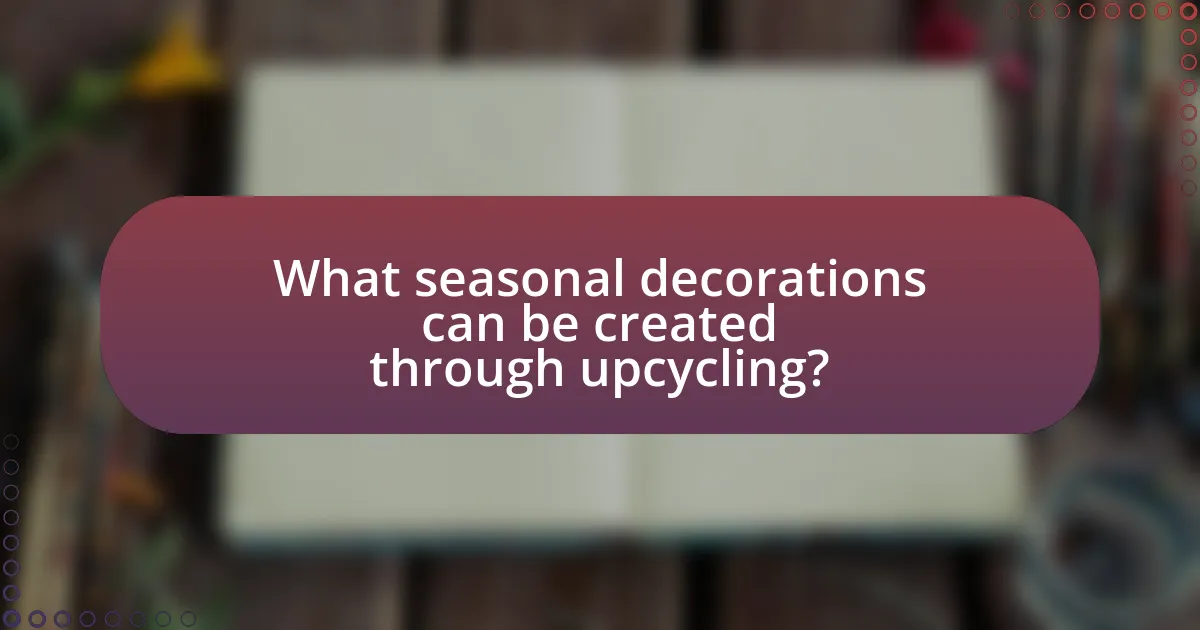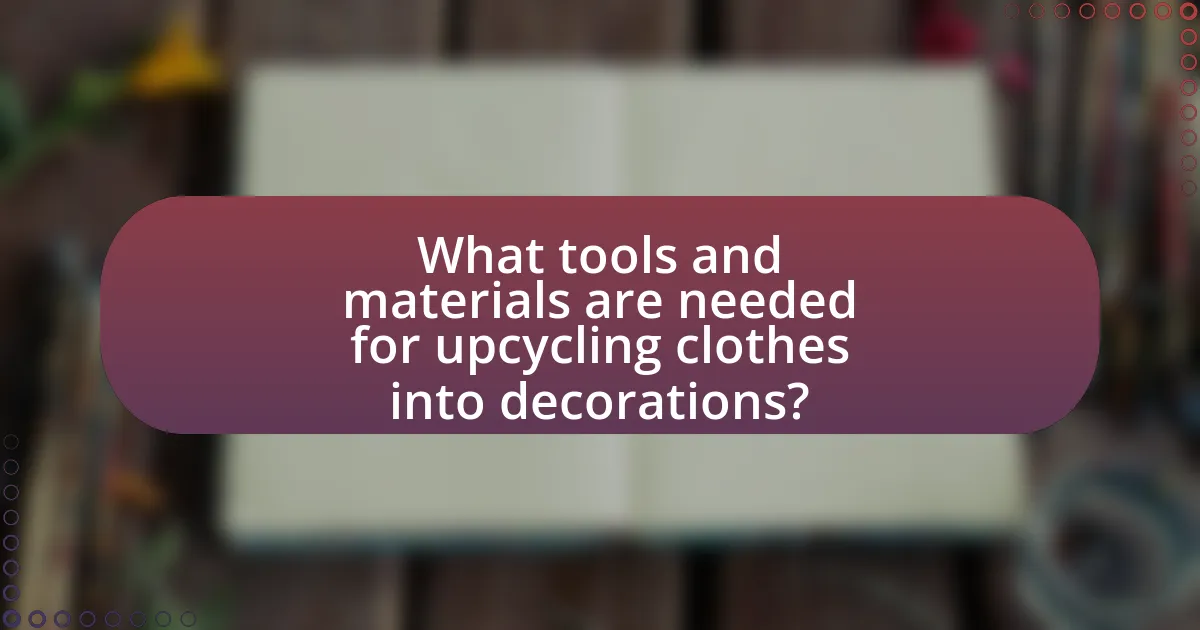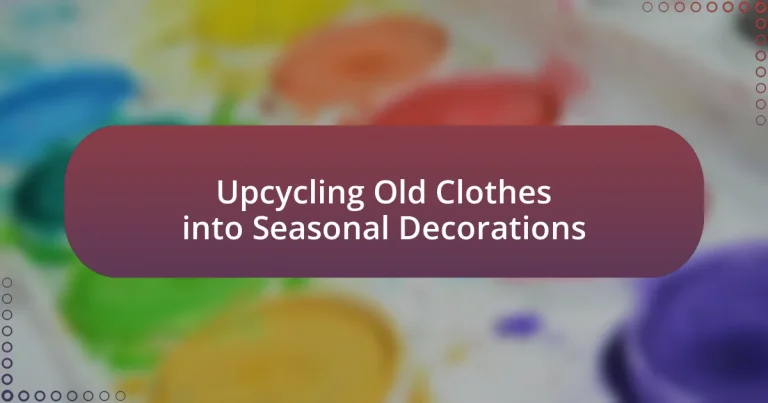Upcycling old clothes into seasonal decorations is a sustainable practice that transforms used garments into decorative items for various seasons and holidays. This process not only reduces textile waste but also fosters creativity by allowing individuals to repurpose fabrics into unique home decor, such as wreaths, garlands, and ornaments. The article explores the types of clothing best suited for upcycling, the environmental benefits of this practice, and practical techniques for creating seasonal decorations. It also highlights essential tools and resources for beginners, emphasizing the importance of creativity and resourcefulness in successful upcycling projects.

What is Upcycling Old Clothes into Seasonal Decorations?
Upcycling old clothes into seasonal decorations involves transforming used garments into decorative items that reflect specific seasons or holidays. This practice not only promotes sustainability by reducing textile waste but also allows for creative expression through the repurposing of fabric. For example, old sweaters can be turned into festive table runners or ornaments, while worn-out jeans can be crafted into unique wall hangings. The process of upcycling contributes to environmental conservation by extending the lifecycle of textiles, thereby reducing the demand for new clothing production, which is known to have significant ecological impacts.
How can upcycling transform old clothes into decorations?
Upcycling can transform old clothes into decorations by repurposing fabric into new decorative items such as wall hangings, cushions, or table runners. This process not only reduces waste but also allows for creative expression, as individuals can choose colors and patterns that match their decor. For instance, a study by the Ellen MacArthur Foundation highlights that upcycling can significantly decrease textile waste, with an estimated 92 million tons of textiles discarded globally each year. By turning old garments into unique decorative pieces, upcycling contributes to sustainability while enhancing home aesthetics.
What types of old clothes are best suited for upcycling?
Old clothes that are best suited for upcycling include denim, cotton, and wool garments. Denim is durable and versatile, making it ideal for creating items like bags or decorative wall hangings. Cotton fabrics, often found in t-shirts and dresses, can be easily transformed into various crafts, such as pillow covers or table runners. Wool, known for its warmth, can be repurposed into cozy blankets or winter decorations. These materials are favored due to their structural integrity and ease of manipulation, which enhances the upcycling process.
How does the upcycling process work for seasonal decorations?
The upcycling process for seasonal decorations involves transforming old clothes into new decorative items through a series of creative and practical steps. First, individuals select clothing items that are no longer worn or needed, such as shirts, dresses, or fabric scraps. Next, they clean and prepare these items by washing and drying them to ensure they are free of dirt and odors.
After preparation, the upcycling process includes cutting, sewing, or gluing the fabric into new shapes or forms that align with seasonal themes, such as wreaths for holidays or fabric garlands for celebrations. For example, a worn-out sweater can be cut into strips and braided to create a festive wreath.
This method not only reduces waste but also allows for personalized and unique decorations that reflect individual style. According to a study by the Ellen MacArthur Foundation, upcycling contributes to a circular economy by extending the life cycle of materials, thereby reducing the environmental impact associated with textile waste.
What are the environmental benefits of upcycling old clothes?
Upcycling old clothes significantly reduces environmental waste by diverting textiles from landfills. Approximately 92 million tons of textile waste are generated globally each year, and upcycling helps mitigate this issue by repurposing materials instead of discarding them. Additionally, upcycling decreases the demand for new clothing production, which is responsible for substantial water consumption and pollution; for instance, producing a single cotton t-shirt can require up to 2,700 liters of water. By extending the life cycle of garments through upcycling, we conserve resources and reduce the carbon footprint associated with manufacturing new textiles.
How does upcycling reduce waste in landfills?
Upcycling reduces waste in landfills by transforming discarded materials into new products, thereby extending their lifecycle and preventing them from being thrown away. This process diverts items such as old clothes from landfills, where they would otherwise contribute to the growing waste problem; in fact, according to the Environmental Protection Agency, textiles accounted for 9.2 million tons of waste in U.S. landfills in 2018. By creatively repurposing these materials into seasonal decorations, upcycling not only minimizes landfill contributions but also promotes sustainable practices and resource conservation.
In what ways does upcycling contribute to sustainable living?
Upcycling contributes to sustainable living by reducing waste and conserving resources. When individuals transform old clothes into new items, they divert textiles from landfills, where they can take years to decompose. According to the Environmental Protection Agency, in 2018, approximately 11.3 million tons of textile waste were generated in the U.S. alone. By repurposing these materials, upcycling minimizes the demand for new resources, such as water and energy, which are required for the production of new textiles. Additionally, upcycling fosters creativity and encourages a culture of sustainability, promoting awareness of environmental issues and inspiring others to adopt similar practices.

What seasonal decorations can be created through upcycling?
Seasonal decorations that can be created through upcycling include wreaths, garlands, and ornaments made from old clothes. For instance, fabric scraps from worn-out garments can be transformed into colorful wreaths by wrapping them around a circular base, providing a unique and eco-friendly decoration for holidays. Additionally, strips of fabric can be braided or sewn together to create festive garlands that can adorn mantels or doorways. Ornaments can also be crafted by cutting shapes from old clothing, such as stars or hearts, and embellishing them with buttons or beads, making them suitable for various seasonal celebrations. This approach not only reduces waste but also allows for personalized and creative expressions in seasonal decor.
How can old clothes be transformed into holiday decorations?
Old clothes can be transformed into holiday decorations by repurposing fabric into items such as ornaments, garlands, and wreaths. For instance, cutting old sweaters into shapes like stars or hearts allows for the creation of unique ornaments that can be hung on a tree. Additionally, strips of fabric can be braided or tied together to form festive garlands, while larger pieces can be wrapped around a foam base to create a colorful wreath. This method of upcycling not only reduces waste but also adds a personal touch to holiday decor, making it both sustainable and meaningful.
What are some creative ideas for Christmas decorations using old clothes?
Creative ideas for Christmas decorations using old clothes include making fabric wreaths, creating ornaments, and crafting garlands. For fabric wreaths, cut old shirts or dresses into strips, tie them onto a wire frame, and add embellishments like pinecones or ribbons. To create ornaments, use old sweaters to make stuffed shapes or cut out festive designs, then hang them on the tree. For garlands, cut fabric into triangles or circles, string them together, and drape them across mantels or doorways. These methods not only recycle materials but also add a personal touch to holiday decor.
How can old clothes be used for Halloween decorations?
Old clothes can be transformed into Halloween decorations by repurposing them into spooky figures, garlands, or table centerpieces. For example, a worn-out white sheet can be cut and draped to create ghostly apparitions, while old shirts can be stuffed and shaped into scarecrows or mummies. Additionally, fabric scraps can be sewn or tied together to form festive garlands or wreaths. This method not only reduces waste but also allows for creative expression in decorating for the holiday.
What are some unique uses for upcycled clothing in seasonal decor?
Upcycled clothing can be uniquely used in seasonal decor by transforming items like old sweaters into festive table runners or using denim scraps to create decorative garlands. For instance, a sweater can be cut and sewn into a cozy table centerpiece for winter holidays, while denim can be fashioned into bunting for summer gatherings. These methods not only reduce waste but also add a personalized touch to seasonal decorations, showcasing creativity and sustainability.
How can fabric scraps be turned into festive garlands?
Fabric scraps can be turned into festive garlands by cutting the fabric into uniform shapes, such as triangles or circles, and then stringing them together using twine or ribbon. This method allows for the creation of colorful and personalized decorations that can enhance any festive occasion. The process involves selecting various fabric scraps, ensuring they are clean and free of any unwanted materials, and then using a sewing machine or hand-stitching to secure the shapes onto the string. This approach not only utilizes leftover materials but also contributes to sustainable crafting practices by reducing waste.
What techniques can be used to create wreaths from old clothing?
Techniques to create wreaths from old clothing include cutting fabric into strips, braiding or twisting the strips, and attaching them to a circular base. This method allows for the use of various textures and colors from the clothing, enhancing the wreath’s visual appeal. Additionally, sewing or gluing fabric pieces onto a foam or wire frame can create a fuller design. Using embellishments like buttons or beads from the clothing can further personalize the wreath. These techniques are effective in transforming discarded textiles into decorative items, promoting sustainability and creativity in home decor.

What tools and materials are needed for upcycling clothes into decorations?
To upcycle clothes into decorations, essential tools and materials include scissors, sewing needles, thread, fabric glue, and embellishments such as buttons or beads. Scissors are necessary for cutting fabric into desired shapes, while sewing needles and thread allow for stitching pieces together. Fabric glue provides an alternative for those who prefer not to sew. Embellishments enhance the decorative aspect, adding unique touches to the final product. These tools and materials are commonly used in various upcycling projects, making them fundamental for transforming old clothing into creative decorations.
What basic sewing tools are essential for upcycling projects?
Essential sewing tools for upcycling projects include a sewing machine, scissors, pins, measuring tape, and thread. A sewing machine allows for efficient stitching and finishing, while scissors are necessary for cutting fabric accurately. Pins help hold pieces together during assembly, and measuring tape ensures precise measurements for fitting and design. Thread is crucial for sewing pieces together and comes in various colors to match different fabrics. These tools are fundamental for transforming old clothes into new, creative seasonal decorations.
How can adhesive materials enhance upcycling efforts?
Adhesive materials can significantly enhance upcycling efforts by providing strong bonds that allow for the creative assembly of various fabric pieces into new designs. These materials enable the seamless joining of different textiles, which is essential in transforming old clothes into unique seasonal decorations. For instance, using fabric glue or adhesive tapes can facilitate the attachment of embellishments or layers without the need for sewing, making the process more accessible and efficient for crafters. Additionally, studies have shown that the use of adhesives in textile applications can improve durability and longevity, ensuring that upcycled items maintain their integrity over time.
What additional decorative items can complement upcycled decorations?
Additional decorative items that can complement upcycled decorations include natural elements like dried flowers, twigs, and stones, as well as handmade items such as macramé hangings and painted terracotta pots. These items enhance the aesthetic appeal of upcycled decorations by adding texture and organic beauty, creating a cohesive and visually interesting display. For instance, incorporating dried flowers can provide a rustic charm that pairs well with fabric-based upcycled pieces, while macramé adds a bohemian touch that complements the creativity of upcycling.
What skills are beneficial for successful upcycling?
Successful upcycling requires creativity, sewing skills, and resourcefulness. Creativity enables individuals to envision new uses for old materials, while sewing skills are essential for transforming clothing into functional or decorative items. Resourcefulness allows upcyclers to effectively utilize available materials and tools, maximizing the potential of what they have. These skills collectively enhance the ability to create unique, sustainable decorations from old clothes, contributing to environmental conservation and personal expression.
How can beginners learn sewing techniques for upcycling?
Beginners can learn sewing techniques for upcycling by starting with online tutorials and beginner-friendly sewing classes that focus on repurposing old garments. These resources often provide step-by-step instructions and visual aids, making it easier for novices to grasp essential skills such as basic stitching, fabric manipulation, and pattern making. For instance, platforms like YouTube and sewing blogs offer a wealth of free content specifically tailored to upcycling projects, which can enhance practical understanding and application. Additionally, community workshops or local sewing groups can provide hands-on experience and mentorship, further solidifying the learning process.
What resources are available for upcycling inspiration and guidance?
Numerous resources are available for upcycling inspiration and guidance, including websites, books, and social media platforms. Websites like Pinterest and Upcycle That offer extensive galleries of upcycling projects, while books such as “The Upcycle: Beyond Sustainability” by William McDonough and Michael Braungart provide in-depth strategies and ideas. Additionally, social media platforms like Instagram and YouTube feature countless tutorials and creative showcases from upcycling enthusiasts, making it easy to find step-by-step guidance and innovative concepts. These resources collectively support individuals looking to transform old clothes into seasonal decorations effectively.
What are some tips for successfully upcycling old clothes into seasonal decorations?
To successfully upcycle old clothes into seasonal decorations, start by selecting fabrics that match the theme of the season, such as warm colors for autumn or bright pastels for spring. Next, cut the clothes into shapes that represent seasonal elements, like leaves or flowers, and use techniques such as sewing, gluing, or tying to assemble them into decorative items like garlands or wreaths. For instance, using old sweaters to create cozy-looking ornaments can add a unique touch to holiday decor. Additionally, incorporating embellishments like buttons or beads can enhance the visual appeal of the decorations. This approach not only promotes sustainability but also allows for personalized and creative home decor.





